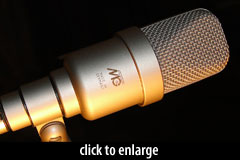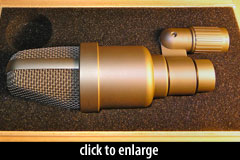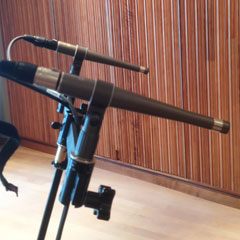
Microtech-Gefell M 930 Ts Review
Monday, March 5th, 2012 | by Paul Strikwerda
The Holy Grail of voice over microphones: is it a mythological object or does it really exist?
If you spend any time on forums for fellow-gearheads, you know that the quest for the best VO-mic can take on Monty Python-esque proportions. People swear by certain brands, makes and models, based on their own (and often vague) criteria.
It is easy to forget that any microphone is part of a recording chain, and when you change one link in that chain, everything changes. Of course the source of the sound is very much part of that chain.
 Very few armchair reviewers actually ask the question: What would make a microphone specifically suitable for voice-over work?
Very few armchair reviewers actually ask the question: What would make a microphone specifically suitable for voice-over work?
Before the home studio revolution, the answer would have been different. Talent would go into a certified soundproof recording studio and use one of the German workhorses on hand.
Nowadays, lots of VO’s hide in walk-in closets, cover themselves in movers’ blankets or buy a prefab foam-filled box from a boothtique. In other words: the ideal voice-over microphone has to handle less than ideal recording environments.
This is what I am looking and listening for in a VO-mic:
- minimal voice coloration
- tight pick-up pattern (cardioid or supercardioid)
- excellent rear rejection
- controlled proximity effect (bass boost)
- low susceptibility to sibilance (shrill “S”-sounds) and popping
- low self-noise
- high-pass filter to cut out lower frequencies
- rugged design, ready for the road
With this in mind, I had been shopping around for a new voice-over mic when a small miracle happened. I became the winner of Recordinghacks’ December microphone giveaway! My prize was the new  Microtech Gefell M 930 Ts studio condenser.
Microtech Gefell M 930 Ts studio condenser.
Prior to that, Gefell had never really been on my radar screen, but when I discovered that Georg Neumann had founded the company in 1928, I was intrigued. Gefell itself had been operating under the East-German radar for years, until the Berlin Wall came down. Now, their hand-made microphones are used in the United Nations, the German Parliament and in The Vatican, as well as in the studios of the BBC and other networks.
My prize possession was developed at the request of Gefell customers and is based on their popular M 930 model. “Ts” stands for Travosymetrierten Ausgang, and that’s German for “output transformer.” That’s exactly what has been added to the M 930, together with a newly developed circuit design. This results in a deeper low-frequency extension, negligible distortion and no signal degradation when running long cables.
A big surprise
I knew I was expecting a large-diaphragm capsule studio microphone, but when I received a package in the mail the size of a brick, I thought somebody had made a mistake. This couldn’t possibly be my new mic, could it? I was almost disappointed.
Out came a simple wooden case with a satin nickel colored microphone and holder that could easily fit in the palm of my hand. It was by far the smallest large condenser I’d ever seen. Judging by this model, Microtech takes its name seriously!
Strangely, the company logo is laser-engraved on the back of the microphone. The model and pick-up pattern symbol are on the front of this side-addressed design. There are no switches such as a bass rolloff, and the M 930 Ts has just one pickup pattern: cardioid. This microphone exudes sophisticated simplicity.
Because of the output transformer, the Ts is longer than the M 930 (130 mm vs 118 mm). It’s also a little bit ‘heavier’ (273 g vs 210 g). In comparison, Neumanns like the TLM 103 and U 87 come in at 500 g.
The high-end steel body–also available in dark bronze–feels very solid, and it is virtually impossible to take this mic apart without damaging it. Gefell actually seals the housing with glue. The 28mm capsule with its gold-plated polyester membrane is mounted elastically in the compact housing, which has a diameter of 45mm.
According to Gefell, the combination of the optimized impedance conversion circuitry and the output transformer gives the microphone a very high maximum SPL 142 dB, with at most 0.5% total harmonic distortion and extremely low self-noise level of just 7dBA. This gives the M 930 Ts a clean, uncolored sound over a wide dynamic range.
This microphone has a constant frequency response with an accentuation of about 2.5 dB between 6kHz and 12 kHz, aimed at raising the speech and high-frequency presence. In theory, this should make it very suitable for broadcasting applications.
The M 930 Ts is connected by a standard 3-pin XLR-male plug with gold-plated pins, and needs an external 48 V phantom power supply.
Size Matters
 If you subscribe to the “bigger is better” theory, you’re not going to like this mic. However, if you believe that small is beautiful, you will love it. A few years ago, my studio went almost completely paperless, and these days I read my voice-over scripts off the computer monitor in front of me. For the first time, I now have a microphone that is not disturbing my field of vision. That’s exactly why the M 930 was developed in the first place: to be discreet. I already find it much easier to concentrate on what’s in front of me, because there’s very little in my way.
If you subscribe to the “bigger is better” theory, you’re not going to like this mic. However, if you believe that small is beautiful, you will love it. A few years ago, my studio went almost completely paperless, and these days I read my voice-over scripts off the computer monitor in front of me. For the first time, I now have a microphone that is not disturbing my field of vision. That’s exactly why the M 930 was developed in the first place: to be discreet. I already find it much easier to concentrate on what’s in front of me, because there’s very little in my way.
If you work for a radio station that is also televising its shows, or if you record YouTube tutorials on your webcam, this mini mic makes sure the focus stays on you and not on some bulky blob blocking your face. On stage, a smaller mic means the audience can actually see and respond to the facial expressions of the performer.
There are three more advantages to this clever design.
First of all, this microphone is easy to position. It fits into tight spaces. Because it is light, you don’t have to worry that your stand will tip over when extending the boom. Third: it’s an ideal compact, sturdy companion for the road.
If you’ve been keeping score, you know I’ve already ticked off a few boxes of my ideal voice-over mic. But there’s more to explore.
Sound check
When my prize arrived, I was already testing a few new microphones in different price ranges. What immediately struck me was that the M 930 Ts is a neutral, natural sounding mic. This is not a microphone that will add a lot of extra “oomph” or a distinct color to your voice, but the sound isn’t exactly thin either. Just like its older brother the M 930, its sound is quite rich without being fat. It sounds transparent, or “unfooled around with” as they say in the commercial. That’s exactly what most of my clients want. They like my audio to be crisp and clear, and if it needs to be sweetened, they’ll take care of that in their studio.
The other thing that struck me from the start is how low the noise floor of this microphone is. This really is a big plus during more intimate reads. The M 930 Ts is rated at 7dBA self-noise, making it one of the lowest self-noise microphones on the market. [See others listed on the Microphone Zeitgeist page. –Ed.]
The cardioid pick-up pattern will give you a reasonable area to work with. For more animated narrators, this means they don’t have to pin themselves down to one spot. At the same time, the off-axis and rear rejection is definitely sufficient to keep the microphone focused, and to keep most extraneous noises out of the mix. This is definitively an advantage under less-than-perfect recording conditions.
I do like my voice-over microphones to have a little bass boost when I get closer to the mic (this is known as “proximity effect”), as long as I get coloration instead of distortion. Up close and personal, the M 930 Ts does add some lower end presence without being too much “in your face.” Sibilance wasn’t really a problem during my test, but that’s also a matter of mic technique. While this Gefell picks up of lot of detail, it is not overly sensitive to popping. Nonetheless I prefer to use a pop filter, if only to protect my mic from mouth moisture.
 As far as I can tell, the M 930 Ts is not yet sold in the U.S. but in Germany it retails for about 1350 Euro (around $1780). The only complaint I have is that this microphone comes with a “hard mount” rather than a shockmount. Gefell charges a shocking $300 for an elastic suspension, and over $200 for a rubber isolation “donut” mount. This mic is quite sensitive, and I do recommend getting something to isolate it. Because it is so small, a universal shock mount won’t hold it securely. Fortunately, I have found a perfect solution at a reasonable price, but more about that in a later review.
As far as I can tell, the M 930 Ts is not yet sold in the U.S. but in Germany it retails for about 1350 Euro (around $1780). The only complaint I have is that this microphone comes with a “hard mount” rather than a shockmount. Gefell charges a shocking $300 for an elastic suspension, and over $200 for a rubber isolation “donut” mount. This mic is quite sensitive, and I do recommend getting something to isolate it. Because it is so small, a universal shock mount won’t hold it securely. Fortunately, I have found a perfect solution at a reasonable price, but more about that in a later review.
Sound Bites
Because I am testing the M 930 Ts specifically as a voice-over microphone, I didn’t want to try it out in a full-blown recording studio, but in a typical, rather small sound booth. When it comes to VO equipment, less is often more, and so I hooked my Gefell up to a CEntrance MicPort Pro, a popular portable mic preamp with a built-in 24bit/96kHz A/D converter. [Read about the MicPort Pro in our USB Mic Pre Shootout –Ed.]
The samples were initially recorded in 24-bit, 44.1 kHz WAV format and converted to MP3.
I thought it would be fun to record one sound bite in Dutch. After all, it is my native language and because the content doesn’t really matter, you’ll be able to focus on the unprocessed sound. What you’ll hear is the short poem Memory of Holland by Hendrik Marsman.
[audio:http://recordinghacks.com/sounds/samples/m930ts-VO/narration.mp3]Next, I recorded my voice at 10, 7 and 5 inches from the microphone.
[audio:http://recordinghacks.com/sounds/samples/m930ts-VO/10inches.mp3]
[audio:http://recordinghacks.com/sounds/samples/m930ts-VO/07inches.mp3]
[audio:http://recordinghacks.com/sounds/samples/m930ts-VO/05inches.mp3]
Finally, I started recording in front of the mic and then I moved to the left and to the right. This should give you a better sense of the way this microphone picks up the source of the sound.
[audio:http://recordinghacks.com/sounds/samples/m930ts-VO/moving.mp3]Conclusion
Based on my criteria, the Gefell M 930 Ts scored 7 out of 8 points, plus a bonus point for size. Apart from lacking a high-pass filter (not a deal breaker) and a shock mount, it has everything a voice talent could hope for. It’s neutral without being boring, and when I listen to my audio samples, I hear myself and not some boutique sound.
Due to its price tag, this is certainly no entry-level mic, but let’s remember that Gefell microphones are still made, measured and tested by hand in Germany.
Great things do come in small packages, and — just like me — the Gefell M 930 Ts is a winner!
Paul Strikwerda is a multi-lingual voice actor based in Easton, PA. Learn more about his voiceover work at Nethervoice.com.
Posted in Broadcast, Microphones, Reviews, voiceover | 24 Comments »




Uncle Karl Littardi
March 5th, 2012 at 5:48 am
One word, in response to your review:
Neat!
Mike McGonegal
March 5th, 2012 at 7:05 am
Paul,
Very nice review. The Gefell sounds, in a word – awesome! One thing that impressed the heck out of me is that you used the MicPort Pro as the pre for the tests. It’d be interesting to see how the M930 sounds paired with differing pres…
Needless to say though, the 930 is now on my list things for Santa to get me next Christmas.
…again, wonderfully done!
-Mike
Paul Strikwerda
March 5th, 2012 at 7:17 am
Thank you, Mike. The MicPort Pro is something I know many voice talents use, either at home or on the road. That’s why I picked it for this review.
I just paired the M 930 Ts with my Grace Design m101 preamp, and it gave the microphone even more presence. Samples will be posted on SoundCloud soon!
Rick Lance
March 5th, 2012 at 11:02 am
Nice review, Paul!
Glad you geared it towards VO talent since that’s all that’s relevant here.
I imagine that the M930 Ts would be pricey for a lot of talent. I’m turning into a mic collector so I’d love to hear the sound. It’s interesting that it’s so compact. A plus for the traveler!
It’s good that you didn’t get too heavy into the specs stuff since many talent can’t relate much to that.
It sounds very smooth, clear, natural with a good proximity effect and rear rejection level (as you put it). That point is often not covered much in mic reviews but is important here since so many of us are just a foot or so from our computers when at the mic.
Looks like you’ve won yourself a great mic! Enjoy!
Paul Strikwerda
March 5th, 2012 at 11:31 am
Thank you, Rick. I feel very lucky indeed!
I think it’s good to remember that part of why so many microphones are relatively cheap is the fact that more and more of them are made in countries like China. Wages are a lot lower and quality control is sometimes an issue.
Like you, I’ll always be curious to hear the latest (and possible greatest) microphones. That’s why I love a site like recordinghacks.com!
I know that this Gefell will faithfully capture my sound for many years to come, and I couldn’t be happier with my prize possession.
steve hammill
March 5th, 2012 at 5:41 pm
Excellent review, Paul. The detail present in your Dutch read is superb. I’ll look forward to listening again in my studio.
Any chance you could put the mic next to a well-known mic like a 416 or a 103 so we could get a better sense of the size?
Paul Strikwerda
March 5th, 2012 at 5:56 pm
Let me put it this way: the Gefell fits in the palm of my hand.
It’s 5.11 inches from top to bottom and 1.7 inches in diameter. In one of the pictures, the Gefell is next to the MXL VO: 1-A, an Avantone CK6 and a Lewitt LCT 640.
Tom Test
March 5th, 2012 at 8:25 pm
Excellent review Paul, and exceedingly well-written. I wonder how my plain-jane M930 would sound like compared to the newer Ts version? In any case, I am very, very happy with my own M930. It is the “go-to” mic that I’ve been searching for, oh, for about a decade.
But you know, I’d never take such an expensive mic on the road with me. I’d be far too nervous about damaging it. Condenser mics are very sensitive. My current travel rig includes the MicPort Pro (of course) and an inexpensive AT2050 that sounds “good enough” for non-broadcast at least.
Paul Strikwerda
March 6th, 2012 at 4:21 am
My guess is that -with the growing number of iPad users- people will increasingly use plug-and-play solutions like the MiC by Apogee when they go on the road.
I can definitely understand your reservations about taking an expensive studio condenser with you. Of course I have not subjected my microphone to the “Samsonite Test” and I don’t think I ever will.
Because of its size, the M 930 makes a compact companion. I’m sure I could find a solid travel case to transport this mic in, or I could take it with me as hand baggage.
However, when I’m on the go, I prefer to leave my work behind for a few days and enjoy some R & R!
Dan Friedman
March 6th, 2012 at 9:38 am
Great review Paul. Even with a quick listen on my laptop… it sounds great.
Dan Friedman
http://www.sound4vo.com
http://www.procommvoices.com
Paul Strikwerda
March 6th, 2012 at 9:51 am
Thank you Dan! For those recordinghacks-fans that do not know Dan, he’s a voice-over talent with a background in audio engineering.
He’s also the author of “Sound Advice, Voiceover from an Audio Engineer’s Perspective.”
Gillian Martin
March 7th, 2012 at 10:12 am
Hi Paul – you sound terrific – especially liked the up close and personal at 5″ – you sound right there! Do you have a whisper room? It sounds so clean. Maybe one day, but my Rode NT 1000 will have to suffice for now. I get all of the above mentioned – slight distortion if I go into mic too close, sibilance and I’m having a problem with some of my p’s. What is the MicPortPro? Similar to an Apogee?
matthew mcglynn
March 7th, 2012 at 10:22 am
@Gillian, yes, the Micport Pro is like the Apogee ONE or Duet, in that it converts the analog microphone signal into digital audio. In a nutshell, it lets you plug a microphone into the computer.
In my experience, Rode mics tend toward the bright side of the sonic spectrum. And I suspect the edge-terminated capsule in the NT1000 might be more prone to popping and distortion than a center-terminated capsule. You might have better luck with a different mic.
Paul Strikwerda
March 7th, 2012 at 10:22 am
Thank you Gillian! The CEntrance MicPort Pro is a popular portable mic preamp with a built-in 24bit/96kHz A/D converter.
You can find a review and shootout of this audio interface by clicking on this link:
http://recordinghacks.com/2009/07/04/usb-interface-review-icicle-micportpro-micmate-x2u/
I record all my voice-overs in a virtually soundproof booth which I built in my basement for under $2000.
Ron Altman
March 8th, 2012 at 8:32 am
Paul,
Enjoyed the review. Lucky man! Would that I could afford that mic. Since I’ve retired from broadcasting, I’ve set up a “home studio” in an attempt to continue using my voice. I’m currently using an MXL-009USB. I like the convenience of just plugging it into the computer. I’d be interested in your opinion of that particular mic. So far, it seems to be doing a great job.
matthew mcglynn
March 8th, 2012 at 9:08 am
@Ron, we haven’t tried the 009.USB, but I know it is one of MXL’s top USB solutions. It has a 24-bit ADC, which is important. But the bottom line is, if you’re happy with the mic’s ease-of-use and performance, then it’s a great fit.
Pierre-Alexandre
March 16th, 2012 at 7:29 am
Hello Paul,
Could you possibly record the same poem with your other microphones, for the sake of comparison?
Paul Strikwerda
March 16th, 2012 at 10:05 am
A head-to-head comparison would be interesting, but the article is written as an evaluation of the Gefell M 930 Ts and not as a microphone shootout.
Pierre-Alexandre
March 17th, 2012 at 1:08 am
Yes, but it can be hard for us, who don’t know what your voice sounds like in real life, to evaluate e M930 Ts without any point of comparison. You took pictures of the M930 Ts together with other microphones to give a better idea of its size, didn’t you? Comparing sounds would serve a similar purpose, only even more relevant.
matthew mcglynn
March 17th, 2012 at 8:25 am
Hi Pierre, perhaps we can do that in a future article.
We do publish a lot of shootouts, and I personally believe that comparisons are useful, but I also want to make room for artists to state opinions and preferences without necessarily having lab results to back up those opinions. See Marc Mommaas’ “Quest for the Ultimate Live Sax Mic” series for another such example. Readers might disagree with his choices, but ultimately he’s the one who has to be satisfied.
Pierre-Alexandre
March 17th, 2012 at 10:04 pm
Hello Matt,
1) I didn’t request lab results. I only wished for comparative recordings.
2) Marc Mommaas’s “Quest for the Ultimate Live Sax Mic” does offer comparative recordings: http://recordinghacks.com/2012/03/15/live-sax-condenser-microphones/
Udo
April 14th, 2012 at 5:35 am
Excellent review. Gefell is -as always- an excellent choice As an owner of the 930 I like to recommend another MIc for VO if the price tag for the 930 comes too expensive. I like to recommend the Mojave FET 201. Check it out if you can´t afford the Gefell 930 TS. The Fet201 is crisp, clean and neutral for VO.
Paul Strikwerda
April 16th, 2012 at 3:34 am
Recently, the M930 Ts won the Musikmesse International Press Award 2012 for best studio microphone. More than 100 magazines from all over the world voted for the best musical instruments and audio equipment of 2011/2012 in more than 40 categories
Mark F
June 18th, 2021 at 8:36 pm
Hello!
After a long search, testing out a bunch of microphones. I, too, have landed on an M930Ts. I love the cute lil’ guy! The first Gefell I got my hands on was a UM70 since I’d seen it used by a couple of pros, and while I really liked the quality of the mic, it sounded pretty awful on my voice. I looked up the rest of their lineup and reviews, and added the M930 to my next round of auditions. On me, it won out easily against the other highly-rated mics, but I was convinced there was still more to be had.
I saw that the same capsule was used in two other very similar mics from Gefell, and eventually found your review here. It was one of so very, very few clues that this microphone even exists, which is surprising given its Neumann heritage and apparent popularity all over Europe, but that settled it. I had to give it a try. So, I asked my very kind retailer if they special ordered an M1030 and M930Ts from Germany for me to test out, if I could still return them. They agreed since they know Gefell will sell!
It was close. Darn close. Sometimes indistinguishable, but to my ear, there were certain times the M1030 sounded ever so slightly veiled in comparison to the M930Ts, which had such a present, clear, honest sound. On listening sessions with some other voiceover actors and engineers, they each said it sounded fantastic and the most, “like you’re standing right here.” I haven’t had the opportunity to try out the “industry standard” U87 yet, but I’d be very curious how they measure up.
Paired with my UA LA-610 Mark II, I’m looking forward to many happy years of yammering into my Gefell!
Thanks so much for your review! It helped give me the determination not to settle with just, “pretty good,” and now I’ve finally found my little diamond in the rough.